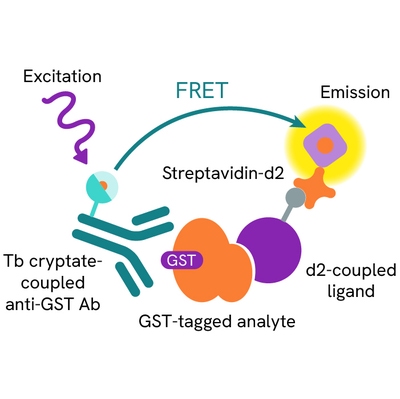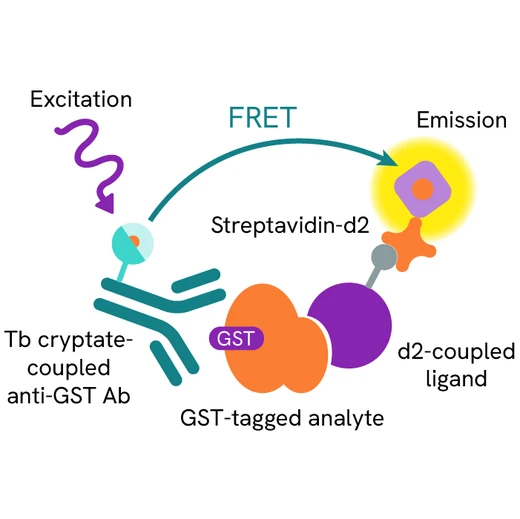

HTRF cIAP1B3 Binding Kit, 10,000 Assay Points








| Feature | Specification |
|---|---|
| Application | Protein-Protein Interaction |
| Sample Volume | 5 µL |









Product information
Overview
A fast and easy way to identify and characterize new binders to cIAP1 protein targeting BIR3 domain.
cIAP1, also named BIRC2, is a member of the Inhibitor of Apoptosis Proteins (IAP) family. IAP proteins are involved in multiple biological processes, such as innate immunity and play an important role in apoptosis inhibition.
cIAP1 overexpression has been associated with cancer resistance, making it an attractive target in cancer therapy, where several therapeutic strategies are investigated such as SMAC mimetics. Moreover, cIAP1 displays E3 ligase activity and leads to targeted proteins ubiquitination and their subsequent degradation, such property being exploited through Proteolysis-targeting chimeras (PROTACs) strategy. Indeed, SNIPERs molecules (Specific and Non-genetic inhibitor of apoptosis protein [IAP]-dependent Protein Erasers) can induce the degradation of both the targeted proteins and IAPs and is expected to harness cancer cells killing.
Therefore, new compounds targeting cIAP1 which exhibit dual role i) inhibition of cIAP1 anti-apoptotic function and ii) induction of targeted protein degradation represent a promising therapeutic approach.
cIAP1, like other IAP family proteins, contains BIR domains which interact with IAP-binding motif of partners such as caspases. This interaction has been suggested to control pro- and anti-apoptotic activities.
cIAP1 compounds characterization on BIR2 and BIR3 domains enables accurate profiling and selectivity studies.
How it works
Assay principle
The HTRF cIAP1 BIR3 Binding Kit is a competitive assay format which uses LCL161 - Red Ligand as cIAP1 BIR3 ligand, a GST tagged human cIAP1 BIR3 binding domain, and an anti GST Terbium-labeled antibody. cIAP1 binding compounds compete with the LCL161 - Red Ligand and thereby prevent FRET from occurring.

Assay protocol
The cIAP1 BIR3 binding domain assay can be run in a 96- or 384-well low volume white plate (20 µL final). As described here, samples or standards are dispensed directly into the assay plate. The human GST-tagged cIAP1 BIR3 binding domain is then added, followed by the dispensing of the HTRF reagents: the anti GST antibody labeled with Terbium cryptate and the LCL161 - Red labeled with d2. The reagents labelled with HTRF fluorophores may be pre-mixed and added in a single dispensing step. No washing steps are needed. The protocol can be further miniaturized or upscaled by simply resizing each addition volume proportionally.

Assay validation
Screening of cIAP1 Orthosteric and PROTAC ligands
cIAP1 anti-cancer drugs either rely on SMAC mimetics (orthosteric cIAP1 compounds) or PROTAC/SNIPER compounds. These compounds have been shown to display lower binding affinity for BIR2 domain than for BIR3 domain or Full-length cIAP1 protein.
Figure 1 : Various cIAP1 compounds were characterized. Orthosteric compounds include LCL161 (assay standard), GDC-0152 and A4110099.1 and display similar Ki values in the nM range, demonstrating accurate determination of compounds’ potencies as well as pharmacological ranking for the cIAP1 BIR3 domain as expected. SNIPER-BRD4 compound (containing the cIAP1 LCL161 and the (+)-JQ-1 BRD4 ligand) shows potency around 100nM. An irrelevant compound Thalidomide (Cereblon E3 ligase orthosteric ligand) does not compete with the binding of cIAP1 fluorescent ligand, demonstrating the specificity of the kit for cIAP1 binders.
Figure 2 : Low affinity bestatin based PROTAC Compounds were tested. Bestatin is a cIAP1 orthosteric ligand known to display low binding affinity ranged between 100 µM – 1 mM. As expected Erα PROTAC Degrader and RAR PROTAC Degrader compounds, which include bestatin as cIAP1 Ligand, exhibit very low potencies with FRET competition detected from 100 µM.


Compounds profiling for cIAP1 BIR3 versus BIR2 domain
Various cIAP1 ligands were characterized. Orthosteric compounds : LCL161 (assay standard), GDC-0152 and A4110099.1 and SNIPER-BRD4 compound (containing the cIAP1 LCL161 and the (+)-JQ-1 BRD4 ligands) demonstrate expected selectivity profile for BIR3 (in the nM range) versus BIR2 domain (in the µM range).




DMSO effect on assay performance
Different percentages of DMSO were tested, from 0.4% to 2% (final per well). The results indicate that the assay window as well as the IC50 do not change significantly with the increasing percentages of DMSO (at least 2% final).

| DMSO effect on the cIAP1 BIR3 Binding Assay | ||||||
|---|---|---|---|---|---|---|
|
% DMSO in final assay volume (20 µl) |
0% | 0.4% | 0.8% | 1% | 1.5% | 2% |
|
% DMSO in compound working solution (5 µl) |
0% | 1.6% | 3.2% | 4% | 6% | 8% |
| IC50 (nM) | 2.5 | 1.8 | 1.4 | 2.0 | 2.0 | 1.7 |
Specifications
| Application |
Protein-Protein Interaction
|
|---|---|
| Automation Compatible |
Yes
|
| Brand |
HTRF
|
| Detection Modality |
HTRF
|
| Product Group |
Kit
|
| Sample Volume |
5 µL
|
| Shipping Conditions |
Shipped in Dry Ice
|
| Target Class |
Binding Assay
|
| Technology |
TR-FRET
|
| Therapeutic Area |
Inflammation
Neuroscience
Oncology & Inflammation
|
| Unit Size |
10,000 assay points
|
Video gallery
Resources
Are you looking for resources, click on the resource type to explore further.
Uncover protein degradation mechanisms with our no-wash assay platforms
This guide provides you an overview of HTRF applications in several therapeutic areas.


Loading...
How can we help you?
We are here to answer your questions.






























